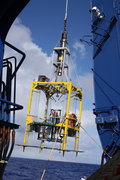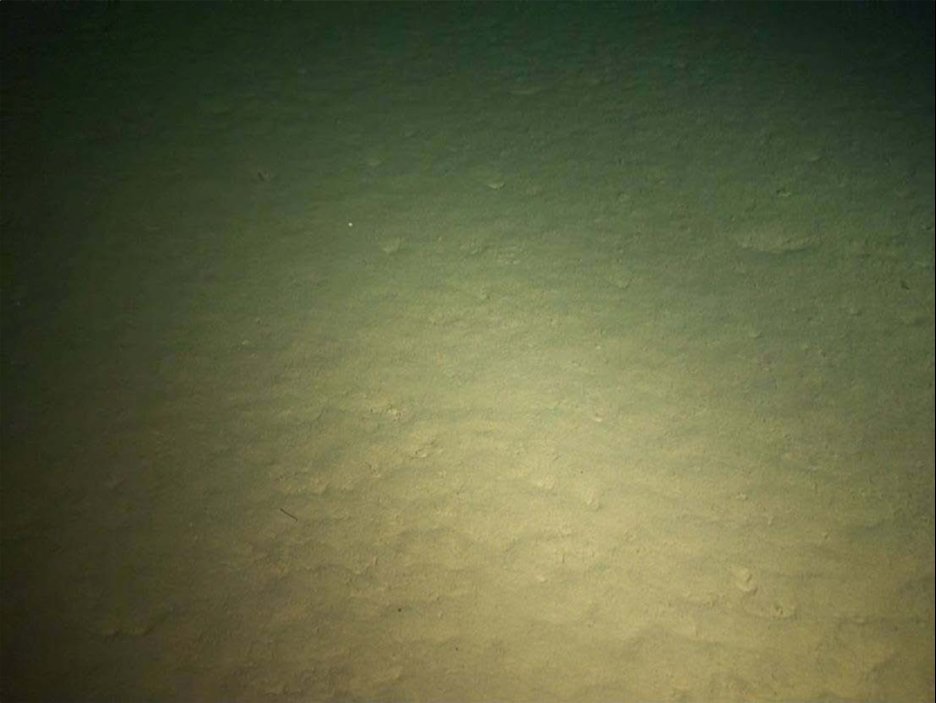Page path:
- Press Office
- Press releases 2011
- 26.01.2011 Climate secrets locked at the bottom...
26.01.2011 Climate secrets locked at the bottom of the Mariana Trench
Climate secrets locked at the bottom of the Mariana Trench -
The deepest part of the ocean traps amounts of carbon
An international team of marine scientists got surprising data from the deepest part of the oceans affecting the world’s climate. For the first time scientists from the Japan Agency for Marine-Earth Science and Technology (JAMSTEC), the Scottish Association for Marine Science (SAMS), the University of Southern Denmark, the University of Copenhagen (Denmark), the HGF-MPG Joint Research Group on Deep-Sea Ecology and Technology from the Max Planck Institute for Marine Microbiology (MPI Bremen, Germany), and the Alfred Wegener Institute for Polar and Marine Research (AWI Bremerhaven, Germany) successfully collected data directly at the bottom of the Mariana Trench located 2000 km East of the Philippines, in a depth of 11000 meters.
A sophisticated deep-diving autonomous lander has carried out a series of descents to the seafloor of the Challenger Deep, a canyon 10.9 km beneath the ocean surface. Here it performed detailed investigations of microbial processes occurring in the sediment. Such detailed science has never been carried out at these extreme depths. The work was carried out during an expedition with the Japanese research vessel Yokosuka (Cruise YK 10-16), with Prof. Hiroshi Kitazato (JAMSTEC) acting as cruise leader.
The deepest part of the ocean traps amounts of carbon
An international team of marine scientists got surprising data from the deepest part of the oceans affecting the world’s climate. For the first time scientists from the Japan Agency for Marine-Earth Science and Technology (JAMSTEC), the Scottish Association for Marine Science (SAMS), the University of Southern Denmark, the University of Copenhagen (Denmark), the HGF-MPG Joint Research Group on Deep-Sea Ecology and Technology from the Max Planck Institute for Marine Microbiology (MPI Bremen, Germany), and the Alfred Wegener Institute for Polar and Marine Research (AWI Bremerhaven, Germany) successfully collected data directly at the bottom of the Mariana Trench located 2000 km East of the Philippines, in a depth of 11000 meters.
A sophisticated deep-diving autonomous lander has carried out a series of descents to the seafloor of the Challenger Deep, a canyon 10.9 km beneath the ocean surface. Here it performed detailed investigations of microbial processes occurring in the sediment. Such detailed science has never been carried out at these extreme depths. The work was carried out during an expedition with the Japanese research vessel Yokosuka (Cruise YK 10-16), with Prof. Hiroshi Kitazato (JAMSTEC) acting as cruise leader.
Fig 1: Recovery of the lander after having completed its mission on the seafloor, scientists onboard ship waited three hours for it to return from the bottom of the Trench with its unique data. In total, the sampling was successfully carried out four times (copyright F. Wenzhoefer)
Fig 2: Map of the Mariana Trench
The Challenger Depth got its name from the British Research Vessel Challenger II, which mapped the deepest part in 1951
Fig 3: Life on board RV YOKOSUKA. Ship crew preparing the lander for its deployment (copyright F. Wenzhoefer)
Fig 2: Map of the Mariana Trench
The Challenger Depth got its name from the British Research Vessel Challenger II, which mapped the deepest part in 1951
Fig 3: Life on board RV YOKOSUKA. Ship crew preparing the lander for its deployment (copyright F. Wenzhoefer)
To better understand the global carbon cycle it is critical to know what role the oceans play in carbon sequestration. Deep ocean trenches make up only 2% of the seafloor but may be disproportionately important as a trap for carbon. The aim of this research was to measure the rate by which organic carbon is degraded at these extreme depths and to estimate from collected sediment samples how much organic carbon is retained in the trenches. The fraction of carbon retained versus degraded in the seabed is crucial to understand the marine carbon cycle and hence the climate of our planet.
The pressure at these great depths is extreme, so to investigate microbial processes in samples from such depths can be very difficult – bringing the organisms to the surface can radically affect them. Therefore scientists around Prof. R.N. Glud (SAMS and SDU) and Dr. F. Wenzhöfer (MPI and AWI) developed an instrument capable of performing the measurements directly on the seafloor at this great depth. Specially constructed sensors probed the sediment in small grids and mapped out the distribution of oxygen in the seabed, providing key insight into the rate at which organic carbon is degraded. To get the “robot” to operate at 10.9km depth was a great challenge. Equipment designed by the team was specially engineered for the mission to function at pressures in excess of 1000 atmospheres. The deployed deep-sea system was a joint effort of Japanese, Scottish, Danish and German scientists. During the cruise the scientist succeeded in performing detailed mapping of microbial activity using highly sophisticated, movable instrumentation and microsensor arrays. Preliminary data from the measurements came as a surprise, as they reveal that the turnover of carbon is much greater at the bottom of the Trench than on the Abyssal plain (6000 metres down). This demonstrates that the seabed in the trenches acts as a trap for organic material and may therefore have high rates of carbon retention. Analyses will be carried out on recovered samples by the research team and they will reveal the rate at which sediment is accumulating at the bottom of the trench. The expedition is a good example of international teamwork. There was a great sense of achievement to study and bring back data from the deepest part of the ocean. Now the researchers expect that this information will help to answer some very important questions regarding carbon mineralisation and sequestration in the ocean trenches.
For further information see also at www.bbc.co.uk/news/science-environment-12183244 and www.sams.ac.uk/sams-news/science-stories/climate-secrets-locked-at-the-bottom-of-the-mariana-trench
The pressure at these great depths is extreme, so to investigate microbial processes in samples from such depths can be very difficult – bringing the organisms to the surface can radically affect them. Therefore scientists around Prof. R.N. Glud (SAMS and SDU) and Dr. F. Wenzhöfer (MPI and AWI) developed an instrument capable of performing the measurements directly on the seafloor at this great depth. Specially constructed sensors probed the sediment in small grids and mapped out the distribution of oxygen in the seabed, providing key insight into the rate at which organic carbon is degraded. To get the “robot” to operate at 10.9km depth was a great challenge. Equipment designed by the team was specially engineered for the mission to function at pressures in excess of 1000 atmospheres. The deployed deep-sea system was a joint effort of Japanese, Scottish, Danish and German scientists. During the cruise the scientist succeeded in performing detailed mapping of microbial activity using highly sophisticated, movable instrumentation and microsensor arrays. Preliminary data from the measurements came as a surprise, as they reveal that the turnover of carbon is much greater at the bottom of the Trench than on the Abyssal plain (6000 metres down). This demonstrates that the seabed in the trenches acts as a trap for organic material and may therefore have high rates of carbon retention. Analyses will be carried out on recovered samples by the research team and they will reveal the rate at which sediment is accumulating at the bottom of the trench. The expedition is a good example of international teamwork. There was a great sense of achievement to study and bring back data from the deepest part of the ocean. Now the researchers expect that this information will help to answer some very important questions regarding carbon mineralisation and sequestration in the ocean trenches.
For further information see also at www.bbc.co.uk/news/science-environment-12183244 and www.sams.ac.uk/sams-news/science-stories/climate-secrets-locked-at-the-bottom-of-the-mariana-trench
Fig 4: Foto from the seafloor at Challenger Deep (Copyright JAMSTEC)
Contact
Dr. Frank Wenzhoefer
HGF-MPG Joint Research Group on Deep-Sea Ecology and Technology. Max Planck Institute for Marine Microbiology (Bremen, Germany) and Alfred Wegener Institute for Polar and Marine Research (Bremerhaven, Germany)
[Bitte aktivieren Sie Javascript] +49 421 2028 - 862
Prof. Ronnie N. Glud
University of Southern Denmark
[Bitte aktivieren Sie Javascript] +45 353 21954
or the press officers
Dr. Manfred Schloesser and Dr. Anja Kamp
[Bitte aktivieren Sie Javascript] +49 421 2028704
Institutes
Japan Agency for Marine-Earth Science and Technology (JAMSTEC)
www.jamstec.go.jp/e/
Max Planck Institute for Marine Microbiology
www.mpi-bremen.de
University of Southern Denmark
www.sdu.dk
Dr. Frank Wenzhoefer
HGF-MPG Joint Research Group on Deep-Sea Ecology and Technology. Max Planck Institute for Marine Microbiology (Bremen, Germany) and Alfred Wegener Institute for Polar and Marine Research (Bremerhaven, Germany)
[Bitte aktivieren Sie Javascript] +49 421 2028 - 862
Prof. Ronnie N. Glud
University of Southern Denmark
[Bitte aktivieren Sie Javascript] +45 353 21954
or the press officers
Dr. Manfred Schloesser and Dr. Anja Kamp
[Bitte aktivieren Sie Javascript] +49 421 2028704
Institutes
Japan Agency for Marine-Earth Science and Technology (JAMSTEC)
www.jamstec.go.jp/e/
Max Planck Institute for Marine Microbiology
www.mpi-bremen.de
University of Southern Denmark
www.sdu.dk


